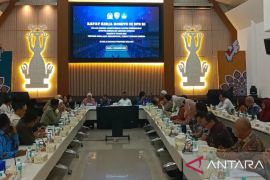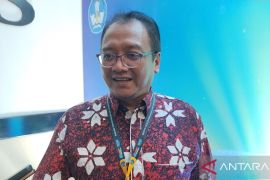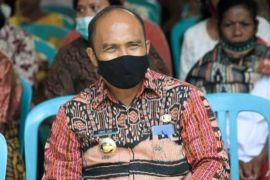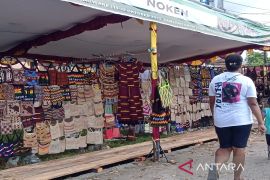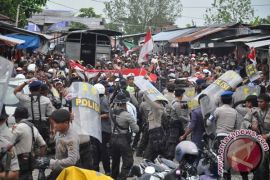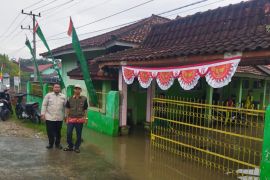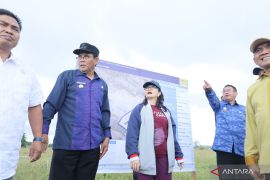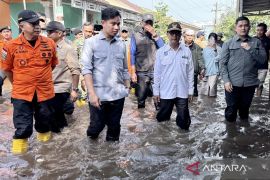"Thank you for this question. This type of question reminds us of paying attention to an important part of the culture of the Papuan People in Mimika, namely the Kamoro and Amugme languages," he said in conversation with ANTARA.
Kamoro and Amugme are two native regional languages in Mimika District that are divided based on region. People in the mountainous area used the Amugme language, while those in the coastal area used the Kamoro language for their daily conversations.
Greetings in the Kamoro and Amugme languages are well known and required to be used at all official and non-official events in Mimika District. In the Amugme language, the word "Amolongo" means congratulations, and in the Kamoro language, "Bimao Witimi" also means congratulations.
In the office environment of the Mimika District Government, it is mandatory to greet in these two languages as a form of respect for the local wisdom of regional culture.
Another step initiated beforehand is publishing Kamoro and Amugme language books for limited groups in schools and also local regional apparatus organizations (OPD).
With these language books, the regional government encourages the younger generation at the formal education level to participate in preserving local languages through learning.
This local language can be included in the learning curriculum in formal education units as a local content subject as part of preserving and loving the local culture.
Every person who inhabits the area must also appreciate the local culture by helping to preserve their regional language to avoid extinction.
The next step taken is publishing Kamoro and Amugme language books in digital versions to reach a wider audience.
Two generations gone
Nowadays, the population in Mimika District is very diverse. Thus, the use of regional languages, Kamoro and Amugme, is becoming rare. The mix of diverse cultures has contributed to the erosion of local culture in the area.
Facing this current reality, several generations of native Kamoro and Amugme tribes are no longer able to communicate using their regional languages.
Native Kamoro academic Leonardus Tumuka stated that the young Kamoro and Amugme generations only understand to the extent of listening but are no longer able to speak their regional language.
What is worrisome about the current condition of the young generation is that members of the second generation after the current one will lose their identity as they no longer master their mother tongue.
Hence, efforts from the local community to preserve their regional languages are needed. If the family no longer speaks the regional language, then the regional language is on the verge of extinction.
The Kamoro and Amugme regional languages must be included in formal education, namely as local content subjects at the elementary, middle, and high school levels.
In addition, it is important to initiate a local language village planning program. This is part of the efforts to keep the Kamoro and Amugme languages from becoming extinct.
Currently, the local community is also facing the challenges of the digital age. The younger generation will easily access external information as material for public consumption and will not prioritize regional languages.
If the Kamoro and Amugme regional languages can be made into modern versions by including them in the digitization system, it will be a big help in saving regional languages from extinction.
Nowadays, mobile phones have become a major need for society. Hence, it can be an opportunity to introduce regional languages through digitalization.
Introducing and cultivating regional languages can take advantage of digitalization, not only in the form of language dictionaries but also in Kamoro and Amugme language folklore and others.
Looking at the example of other regions in Indonesia, several folk tales from a region are made into cartoon films. This local wisdom has been modernized to preserve their culture.
Revitalization
As a concrete manifestation of the revitalization of the Kamoro and Amugme regional languages, the Regional Regulation Agency (Bapemperda) of Mimika District, Central Papua, in 2023 discussed draft regional regulations with the Papua Province Language Center to protect regional languages and literature.
Chairman of the Mimika Bapemperda, Iwan Anwar, stated that discussion of the draft aims to provide an overview of the importance of preserving local regional languages.
Maintaining and preserving regional languages must be carried out with regulations as the basis for protecting local cultural assets.
The discussion and draft of these regional regulation will be ratified as a regional regulation in 2024.
This regulation is important since members of the younger generation tend to converse in loanwords rather than in their regional languages. This phenomenon is a threat to the continuity of local wisdom.
Hence, it is necessary to encourage the use of regional languages to be included in local content lessons in formal education units so schools can also implement local regional wisdom.
The stipulation of the regional regulation is in accordance with Law Number 24 of 2009 concerning "Flag, Language, and National Emblem and National Anthem."
In addition, it is regulated in Government Regulation Number 57 of 2014 concerning the development, guidance, and protection of language and literature.
The proverb "When in Rome, do as the Romans" serves as a reminder that efforts to preserve regional languages are not only the obligation of cultural observers but also an inseparable part of joint efforts, as a form of joint commitment to safeguard the Land of Papua and preserve its local wisdom.
Related news: Fourteen passengers rescued after Smart Air plane runs off runway
Related news: Minister reviews development programs in Central Papua's Puncak
Translator: Agustina Estevani J, Resinta Sulistiyandari
Editor: Anton Santoso
Copyright © ANTARA 2024

